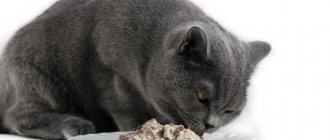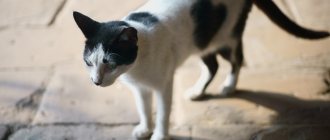Causes of diseases
With a strong immune system, pathogens do not cause significant harm to the cat. The animal's saliva contains thiocyanate ions, which destroy bacteria, and lysozyme, an enzyme that lyses food particles and prevents microorganisms from feeding.
Lysozyme destroys pathogenic cells or slows down their reproduction by facilitating the access of thiocyanate ions.
When the body’s defenses are weakened, the oral cavity and pharynx are at the forefront; the gums (gingivitis) and tonsils are especially affected.
The formation of tartar begins with plaque; when bacteria attach, the plaque thickens and gradually increases.
What to do at home?
If you notice dark spots around your cat's mouth, you should consult your veterinarian. Treatment depends on the cause of the rash. Acne is often a consequence of liver dysfunction, especially in older animals. Therapy in this case includes changing the diet in such a way as to minimize the load on this organ.
It is quite easy to suspect an infectious disease at home, as this will affect the pet’s behavior. Infections weaken the body, so the cat will be lethargic, sleep a lot and refuse to eat. It is important to exclude the allergic nature of the rashes. To do this, you need to put the cat on a diet and replace the bowl with a glass one. Often, plastic bowls painted in bright colors with low-quality dyes are the cause of acne.
You should fight dark spots at home with the help of antiseptics. It is necessary to apply a cotton swab soaked in chlorhexidine, miramistin or hydrogen peroxide to the dark areas. Treatment is carried out 2-3 times a day.
You should definitely use vitamin supplements for animals aimed at normalizing immunity. You should consult your veterinarian about additional measures.
Sometimes owners notice that the cat has black spots in its mouth and begin to worry. In fact, this phenomenon occurs quite often. It is inherent not only in cats, but also in dogs. In most cases, we are talking about natural processes that do not pose a threat to the health and life of the animal. Only occasionally are dark spots in or around the mouth caused by some kind of pathology. This article discusses the most common reasons.
The first signs of pathologies
The very first symptom of oral diseases in cats is anorexia, food refusal. This is explained by pain when chewing and swallowing food. A typical symptom is a cat sitting near a bowl or water, trying to eat (drink), but cannot due to a strong inflammatory reaction and pain.
Inspecting the oral cavity at home on your own is problematic; even a calm animal does not allow the owner to forcibly open its mouth.
Heavy, bad breath indicates a problem with the teeth (tartar), infection, ulcers, or suppuration.
An unkempt appearance in a cat indicates that it has stopped licking itself, which is almost impossible with diseases of the oral cavity. Drooling, which causes the fur on the chin and front legs to become damp, is a symptom that indicates a problem.
Symptoms of oral diseases in cats:
- lack of appetite;
- dysphagia (difficulty swallowing);
- ptyalism (excessive drooling);
- halitosis (pungent odor);
- weight loss;
- trying to get something out of your mouth.
With stomatitis and gingivitis, a strong odor from the mouth is felt from a distance. You can suspect a foreign body in the pharynx based on symptoms of choking, nausea, drooling and difficulty swallowing.
More serious problems
Thus, a cat's tongue can be a real "barometer" of health. A change in color is an indicator that your cat may be sick. You can remember a simple truth: “A pink tongue is a healthy pet.” This rule is immutable; exceptions are very rare.
Why is that? The fact is that the tongue, as a muscular organ, is literally penetrated by many blood vessels, visible through the thin epithelial layer. If it is pink, everything is in order - the blood supply is normal, the red blood cells contain the required amount of hemoglobin. In many cases, a white tongue is a sign of poor oral hygiene, but below we will describe much more serious pathologies in which this organ also changes its color.
Oral diseases: list and characteristics
Cats suffer most from gum disease that develops as a result of feeding poor quality food. Symptoms: hyperemia, swelling, ulcers, similar to signs of scurvy.
- Inflammation of the gums.
A strong odor from the mouth indicates tartar, an accumulation of food particles between the teeth. During the inflammatory process, there is a danger of tooth decay and the development of periodontitis.
Upon examination, reddened, swollen gums are visible, painful with areas of bleeding. If left untreated, the gums gradually recede from the tooth, forming pockets in which food accumulates. Putrefactive inflammation, caries, and periodontitis develop. The cat refuses to eat, becomes weaker, has unkempt fur, and saliva may flow from its mouth.
- Inflammation of the tongue.
Infectious pathology, glossitis, indicates immunodeficiency conditions, feline leukemia, acute respiratory disease, viral immunodeficiency syndrome. Sometimes the inflammatory process appears when exposed to external factors, licking highly irritating substances. Symptoms: profuse salivation, sometimes foamy, anorexia, pain. Externally, the cat looks unkempt. After healing and disappearance of the inflammatory process, the surface of the tongue is smoothed, it becomes varnished, smooth without a hard brush. Erosion and ulcers often form.
- Stomatitis.
Oral disease is manifested by severe salivation and inflammation of the mucous membrane. The cat refuses to eat, inspection of its mouth is difficult, it rubs its face with its paws and shakes its head.
Redness and swelling are noticeable on the mucous membrane, gums bleed, and there is a strong odor from the mouth. The cat seems to be “ruffling up”, looking unkempt and disheveled. In young cats, candidiasis (thrush) is diagnosed; the disease becomes more pronounced when treated with antibiotics, steroids, with low immunity, or after a serious illness. Symptoms of thrush: a whitish film on the tongue, gums; if left untreated, ulcers form on the mucous membrane.
- Pharyngitis.
This is a rare disease of the oral cavity, occurring as a secondary pathology against the background of a viral infection, diseases of the mouth and pharynx. With pharyngitis, the temperature rises, pain, cough, and nausea appear. No appetite.
- Tonsillitis.
Inflammation of the tonsils is rarely diagnosed in cats. Hyperthermia (above 39.4C), lethargy, and anorexia are observed. The underlying cause of the disease is a bacterial infection.
In case of recurrent tonsillitis, removal of the tonsils is indicated, since greatly enlarged tonsils interfere with the normal passage of air into the lungs, cause attacks of suffocation, and interfere with food intake.
- Neoplasms of the salivary glands.
Cysts and tumors form under the influence of external factors. As a rule, the salivary gland is damaged in cat fights, when a foreign object enters. The accumulating fluid ruptures the duct and a cyst is formed - a mucocele.
The submandibular gland is most often affected; when palpated under the tongue, a smooth, large cyst can be detected. Neoplasms disturb the animal, making it difficult to breathe and swallow. More often, complete removal of the damaged salivary gland is required; punctures and rinses do not give the desired effect.
In older cats, tumors are (usually) malignant and appear as hard, slow-growing lumps on the side of the face or neck.
- Foreign bodies.
Needles, bones, fragments, chips, thorns, threads get into the oral cavity. The specific structure of the tongue with papillae curved inwards does not allow a foreign object to fall out. It is easy for a breeder to understand that something has got into the cat’s mouth; she shakes her head, meows, and tries to reach with her paws what is bothering her. Severe drooling, restlessness, refusal to eat.
Particularly dangerous are the bones from fish, which dig into the soft tissues of the mouth and pharynx and “sit” there without causing signs of concern. After a few days, the bone rots, a strong odor from the mouth appears, intoxication, weakness, and apathy develop. If the outcome is successful, the bone comes out with a ruptured abscess and pus.
- Jacobs ulcer.
It is found in the middle of the upper lip, sometimes on the lower or oral mucosa. It looks like a yellow or reddish shiny spot that turns into a weeping erosion without pain or itching. Diffuse growth: the ulcerated surface increases, teeth and gums are exposed. Jacobs ulcer has a tendency to develop into cancer or fibrosarcoma. The cause of the pathology is not clear; a connection is suggested with dental infections and the feline leukemia virus.
What type of coating on a cat's tongue is considered normal?
- Causes
- Colored coating
- Treatment methods
Cats always spend a lot of time cleaning their bodies.
Every day you can see the pet licking its fur. This gives the impression of a very clean animal. They begin primarily not to remove dirt from the surface of the hairs, but to eliminate odor. Since the furry cat uses its tongue to carry out procedures, organ damage is often diagnosed by veterinarians.
A caring owner should regularly inspect the mouth of his four-legged friend. If any abnormalities are detected, you must contact an animal clinic. Quite often you can notice a coating on a cat’s tongue. In this case, of course, you should be wary.
Most pathologies that develop on the surface of the organ are dangerous not only to the health, but also to the life of your pet.
Causes
A cat's tongue is a multifunctional organ that allows it to eat and drink from a spoon, as well as keep its fur clean. Normally, the color of the organ should be pink and clear. Thus, any deviations in the body appear precisely on its surface.
Organ disease immediately affects the quality of nutrition. The animal ceases to receive the required amount of food and water, and, accordingly, nutrients, since pain simply does not allow eating and drinking.
Among the reasons why a white coating appears on a cat’s tongue are:
- Stomatitis. A fairly common disease among cats. Manifested by whitening of the surface. The gums and tongue become swollen. Painful ulcers appear. There is inflammation of the throat and the entire mucous membrane of the oral cavity. The animal has difficulty opening its mouth, and there is significant difficulty in taking food and water. The pet is losing weight. The condition of the coat noticeably deteriorates. There is general lethargy and malaise. Exhaustion and dehydration may occur, which is extremely dangerous and requires immediate assistance;
- Glossitis. Very often, an infectious disease is diagnosed in cats. Pathogens cause severe inflammation and swelling of the organ. When the mucous membrane begins to peel off, a whitish coating is observed. The spines on the surface of the tongue disappear. The organ becomes covered with ulcers, which are very painful. The wool takes on a wet appearance. A clean-loving animal simply cannot clean its hairs due to pain. The disease requires immediate assistance from a veterinarian;
- Gingivitis also manifests itself as a whitish coating. Since inflammation occurs on the surface of the gums, first of all you can notice deviations on them, and then on the tongue;
- Tartar. The disease occurs at the initial stage with a characteristic change in the color of the tongue tissues. To remove the symptom, you can use a weak water-salt solution, which must be used to treat both the teeth and the organ itself. An analogue can be baking soda. Such treatment will prevent serious consequences;
- Gastritis. The characteristic white color can be seen on the root of the organ. The inflammatory process on the gastric mucosa occurs with darkening of the root, but such plaque can only be noticed during the period of exacerbation of the pathology;
- Fungal diseases. They are considered very dangerous illnesses. If you do not start timely treatment, your pet may be in serious danger. The most common is oral candidiasis. Among the main symptoms is a very foul odor from the mouth. The fungus very often torments cats that have been treated for a long time with antibiotics or non-steroidal drugs;
- Chemical substances. Cats are very curious, so chemicals in the house should be kept out of reach. Some substances cause burns and poisoning, and dangerous compounds upon contact with the surface of the tongue cause a change in its color.
The surface of the organ can take on different colors. Thus, the following aspects are highlighted:
- If you notice a brown coating on your cat’s tongue, then don’t panic. In most cases, this phenomenon is observed in red breeds. Special pigmentation manifests itself in the form of characteristic freckles on the organ, which give the surface a brown color. The reasons are still unknown. If you have serious concerns about your pet’s health, you should contact a veterinarian and show the condition of the oral cavity;
- A black coating on a cat's tongue is most often observed after eating soil or dirt. Usually found in animals that have free access to the outdoors. There is also no need to worry, since this is not a disease.
You should be wary when a white or gray coating appears on your cat's tongue. These colors indicate abnormalities occurring in the pet’s body. Requires examination by a veterinarian and prescription of special treatment. In most cases, medications, injections, droppers, and treatment of the surface of the organ with healing solutions are prescribed. The treatment regimen is prescribed by a specialist.
If there is a cat living in the house, then you need to constantly monitor the appearance, well-being, and condition of the animal’s oral cavity. Only timely assistance will eliminate serious consequences and death.
Source: https://okoshkah.com/nalet-na-yazyke-u-koshki.html
Developmental anomalies and acquired pathologies
In fights, cats receive lacerations in the mouth area; less often, the animal injures itself by accidentally biting its lip. The tongue can be cut on sharp objects (tin cans), or peeled off by accidentally licking an iron object in the cold.
Squamous cell carcinoma, a malignant tumor, forms around the nose and on the lips, mucous membranes of the mouth and tongue. Neoplasia must be differentiated from eosinophilic ulcers by biopsy.
Nasopharyngeal polyps are localized in the nasopharynx, closer to the back of the nose, in the passage to the throat. Provoke difficulty breathing and swallowing food. Polyps are removed surgically.
Cleft lip in cats, a congenital defect, is characterized by incomplete development of the upper lip. The pathology is visible at the birth of a kitten, sometimes the cleft lip is combined with a cleft palate.
Cleft palate, a disease most often of a genetic nature, is sometimes diagnosed along with cleft lip. The disease manifests itself in the first day of life, the kitten has difficulty sucking milk, and it leaks into the nose. The anomaly is accompanied by constant sneezing, noises are heard when breathing, and pneumonia develops when milk gets into the lungs.
Any disease requires the attention of a veterinarian and consultation within the walls of a veterinary clinic. The first symptoms of illness cannot be ignored. Diseases of the oral cavity and pharynx in cats are easier to treat at first. In advanced cases, excessive efforts will be required, and sometimes the disease ends in death.
Mycoplasmosis
Another probable reason why a cat has blackness around its mouth is mycoplasmosis. The disease is infectious and develops due to the action of single-celled microorganisms of the same name - mycoplasmas.
The disease is characterized by a number of symptoms:
- Conjunctivitis.
- Purulent discharge from the eyes and nose.
- Loss of appetite.
- Changes in the color of the mucous membranes.
Often, infection is accompanied by the formation of dark spots around the mouth, on the tongue and on the mucous membrane of the lips. Mycoplasmosis is most dangerous for pregnant cats, as it can cause miscarriage.
The disease develops against the background of decreased immunity, since mycoplasmas belong to the group of opportunistic microorganisms that are always present in the animal’s body. Therapy is based on measures to strengthen the immune system and the use of antibacterial agents.
How to call a veterinarian at home?
What questions will need to be answered?
We invite you to familiarize yourself with: British marbled shorthair cat or “tabby”
In order to call a veterinarian, you need to:
- Call the operator at the numbers specified in the Contacts section;
- Tell what happened to the animal;
- Provide the address (street, house, front door, floor) where the veterinarian will arrive;
- Specify the date and time of the doctor’s arrival
Call a veterinarian at home and he will definitely help you. At home, as they say, walls can be healed.
Similar symptoms:
Lentingo
Behind the “scary” word “lentingo” lies an absolutely harmless phenomenon that explains why a cat has black spots in the mouth (on the gums or palate) and near it (on the nose, on the lips, on the chin). This skin defect is a common pigmentation that is also characteristic of humans.
Lentingo is the most common cause of dark spots in the mouth. In the vast majority of cases this is exactly what happens. Kittens usually have clean, uniform oral tissues. Later, small spots a few millimeters in size may appear.
Over time they grow and sometimes reach a couple of centimeters. Their number often increases. You can notice lentingo already at the end of the first year of a cat’s life, if she is prone to its appearance. At a later age, spots rarely appear.
Most often, lentingo in or near the mouth is noticed in ginger cats. This can be compared to freckles, characteristic of people with sunny hair color and fair skin. Also in the “risk” group are tortoiseshell cats. Lentingo spots
:
- smooth;
- do not protrude above the surface of neighboring tissues;
- do not peel:
- don't itch;
- don't hurt;
- do not cause any other discomfort to the animal.
If everything is exactly as described, there is no reason to worry. Although it wouldn’t hurt to show the cat to the doctor just in case.
Acne
If your cat has black spots near the mouth rather than inside it and they look more like dots, it may be acne. They love to “settle” on the chin, where the sebaceous glands are most active. However, they can appear in other places. The most common causes of acne are
:
- Unbalanced nutrition, when the diet lacks the vitamins and minerals the cat needs. This often happens if the animal is fed from a common table.
- The sloppiness of a cat that walks around with food residue on its chin.
- Poor environmental conditions.
- Severe stress experienced by the animal.
- Dirty dishes.
- An allergic reaction to a detergent or other irritant.
- Hereditary factor.
All other causes, except the last one, can be eliminated, and the black spots around the mouth will disappear. If it’s a matter of genetics, you will have to come to terms with and console yourself with the thought that the spots do not cause any harm to the cat’s health.











